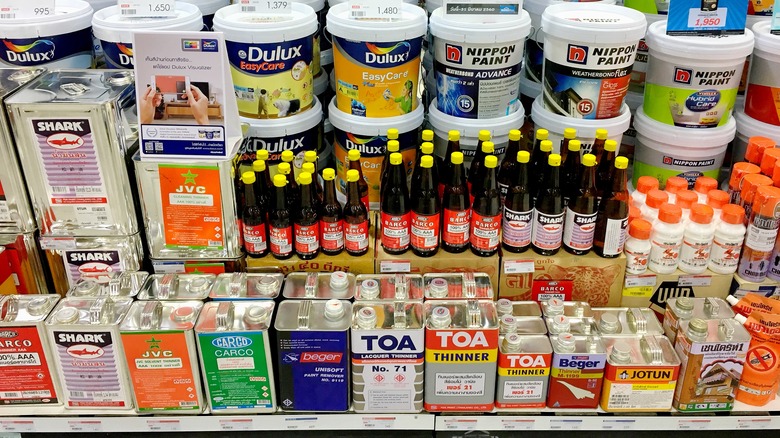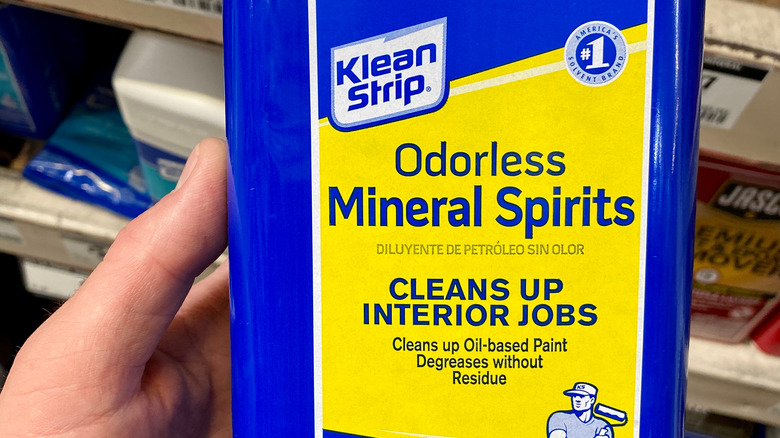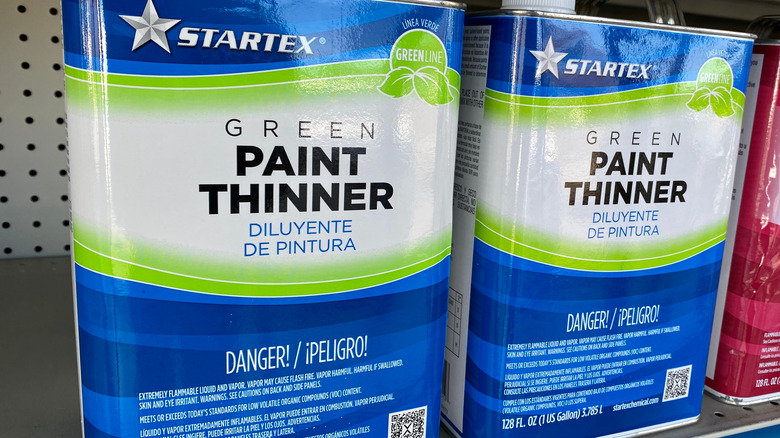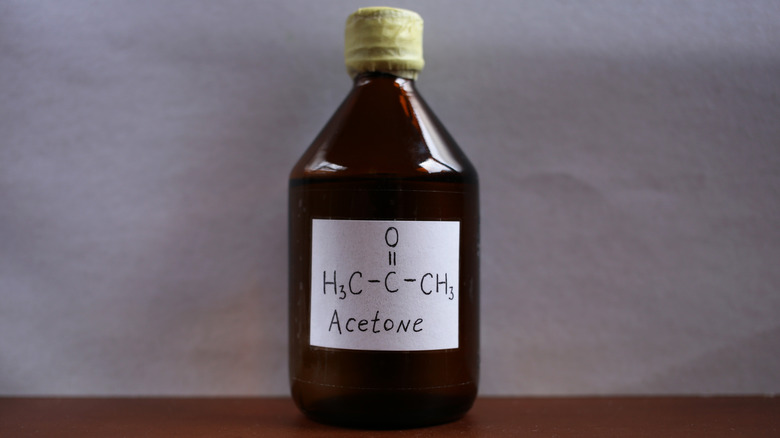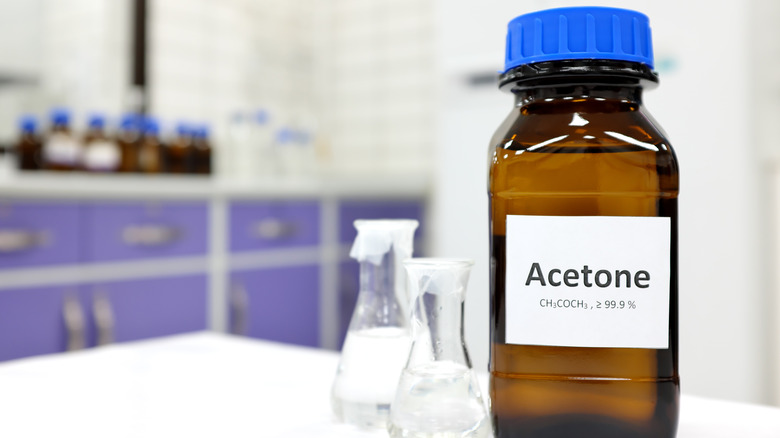The Real Difference Between Mineral Spirits, Paint Thinner, And Acetone
If you've ever done any kind of painting around your home, you are probably at least a little bit familiar with mineral spirits, paint thinner, and acetone. They all remove paint, while others can thin paint, and some are excellent for cleaning up not only paint but other messes. However, while they have similar uses, these three solutions are not the same.
It's worth noting the differences between these compounds in order to get the most out of them and to avoid any mishaps. For one, mineral spirits and paint thinner are petroleum-based products, which means they are effective for thinning and removing paint, but neither work well with latex paint (stick with water for that). Mineral spirits contain only one ingredient: purified, distilled petroleum, while paint thinners can include many ingredients. Acetone differs from both of these solvents in that it is an organic compound found in trees and plants, says Bob Vila, that is mixed with other additives (via Verywell Health).
What are mineral spirits?
Mineral spirits, sometimes referred to as white spirits, are often used as a paint thinner and degreaser. It can also be found in some paints, waxes, furniture polishes, and dry cleaning fluids. The solvent is made of hydrocarbons, which is a type of poison, according to the University of Florida.
Aside from thinning paint, mineral spirits, which is a clear liquid, can also be used to thin varnishes and stains. Additionally, it's important to remember that it can remove wet paint, but not dry paint, and the material does not work well with products containing asphalt (via The Spruce).
Mineral spirits, especially odorless mineral spirits, are popular among artists because the compounds that cause the odor have been removed, per Professional Artist. That being said, the fumes from both are dangerous and you should always use mineral spirits in a well-ventilated room when you are working on a project.
What are paint thinners?
Paint thinner is a term that describes many solvents used to thin paint or help remove paint from brushes. For example, turpentine, acetone, toluene, and even mineral spirits are all paint thinners, as noted by Bob Vila. That being said, paint thinners can also include mineral spirits, says Atlanta Environmental Incorporated. However, mineral spirits are less toxic than most paint thinners, including acetone, which makes them a favorite among many do-it-yourself enthusiasts.
There are advantages to using paint thinners as opposed to mineral spirits or even acetone. For one, they are safer around children, and they have less of an odor. They are also less flammable and less combustible. However, if they are being used in a small area with no ventilation, it is possible that a pile of towels soaked in paint thinner could combust. Finally, paint thinners tend to be cheaper than mineral spirits, which is a plus, but it is more difficult to dispose of paint thinners (via Bob Vila).
What is acetone?
Acetone is somewhat more versatile than mineral spirits and paint thinners; while it can be used to thin paints, it has other uses as well. For example, acetone mixes well with water, which makes it an ideal ingredient in many solvents. Perhaps one of its more popular uses is nail polish remover. Acetone is also an ingredient in many cleaners because it is a powerful glue and stain remover. In addition, it lifts away gum and other sticky compounds from silk and wool. Acetone is also used to add protective coatings on cars and furniture, and to dissolves Styrofoam, states Verywell Health.
Other uses for acetone include the production of plastics used for signs, lighting fixtures, displays, and the use of manufactured fibers (via Shell). The pharmaceutical industry even uses acetone to make pills and liquids because it helps determine the correct amount of active ingredients, notes U.S. Chemical Storage.
Exposure to mineral spirits and paint thinners
Exposure to excessive amounts of mineral spirits can cause poisoning. If you breathe too much into your lungs, you may have difficulty breathing and your throat may swell. Breathing too much of it can cause severe throat pain or a burning sensation in your eyes, ears, lips, or tongue. If ingested, mineral spirits can cause stomach pain, vomiting, and bloody stools, warns Mount Sinai. High exposure can also cause skin irritation, low blood pressure, dizziness, loss of memory, numbness in the arms, a fast heart rate, and even collapsing.
The symptoms of exposure to paint thinner are similar to that of mineral spirits. Being exposed to it, however, can increase your chances of developing kidney inflammation or pneumonia, cautions Healthfully. Call poison control in your area if someone you know has been exposed to high amounts of mineral spirits or paint thinner. Rinse the skin or eyes, if necessary, and move the individual outside to fresh air.
Exposure to acetone
Small amounts of acetone that make it into the body either though skin or from breathing fumes are usually filtered out through the liver. However, if large amounts are breathed in over a short period of time, it can lead to acetone poisoning. This can cause irritation of the throat and nose; other symptoms include headaches, nausea, vomiting, high heart rate, confusion, and coma in rare cases. When the skin is exposed to too much acetone, it will become cracked, dry, and red, per Verywell Health.
In rare cases, acetone poisoning occurs when the liver cannot break down the amount of acetone in the body fast enough. Acetone is a ketone, and when your body has too many ketones, it goes into ketoacidosis. People with type 1 or type 2 diabetes are susceptible to ketoacidosis if they don't manage their glucose levels (via Healthline).
Mineral spirits, paint thinner, and acetone all have their place, and once you understand how to use them properly, you can head into your next home project with confidence.
